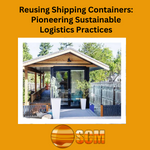In today’s world, where the urgency of addressing climate change has become increasingly evident, businesses are seeking innovative ways to incorporate sustainable practices into their operations. One area that has captured the imagination of entrepreneurs and environmentalists alike is the repurposing of shipping containers. No longer confined to traversing the world’s oceans, these steel boxes are being creatively reused, contributing to sustainable logistics practices that benefit both businesses and the environment. This article will delve into the concept of sustainable logistics, explore the benefits of reusing shipping containers, provide examples of their innovative applications, discuss the challenges involved, and offer a glimpse into the future of this trend.


Sustainable Logistics: Minimizing Environmental Impact, Maximizing Benefits
Sustainable logistics involves managing the flow of goods and services in a manner that minimizes negative environmental impacts while maximizing economic and social benefits. It encompasses reducing carbon emissions, minimizing waste, and promoting ethical and socially responsible practices throughout the supply chain. By repurposing shipping containers, businesses can embrace sustainable logistics practices and contribute to a greener future.
The Environmental and Economic Benefits
Reusing shipping containers in logistics offers numerous benefits. First and foremost, it significantly reduces waste by repurposing materials that would otherwise end up in landfills. This approach aligns with the principles of a circular economy, where resources are reused and waste is minimized. Additionally, utilizing shipping containers as storage or transportation units can be more cost-effective than constructing new structures or purchasing traditional containers. This cost savings allows businesses to allocate resources to other sustainability initiatives. Furthermore, reusing shipping containers presents an opportunity for businesses to demonstrate their commitment to sustainability and differentiate themselves from competitors.
Innovative Applications of Shipping Containers


The versatility of shipping containers has inspired a myriad of innovative applications in logistics. One notable example is their use as mobile pop-up shops or restaurants. By repurposing containers, businesses can easily transport their stores or eateries to different locations, offering a unique and sustainable way to reach customers. The mobility and flexibility of shipping containers present an exciting opportunity for entrepreneurs seeking creative business models.
Another application involves transforming shipping containers into modular housing units for workers in remote locations. This addresses the need for affordable housing while simultaneously reducing the environmental impact of traditional housing construction. It is particularly relevant for industries such as mining, oil, and gas, where workers often reside in temporary camps. By repurposing shipping containers, companies can provide comfortable accommodations while minimizing their carbon footprint.
Furthermore, repurposed shipping containers can serve as storage units for businesses, reducing the need for new construction and promoting sustainability. This approach is especially beneficial for companies with fluctuating storage needs or those operating in areas where land availability is limited. By utilizing containers, businesses can optimize their storage capacity while minimizing their environmental impact.
Challenges and Considerations
Implementing sustainable logistics practices using shipping containers is not without its challenges. Retrofitting containers for specific purposes can be costly, requiring investments in modifications and ensuring compliance with safety regulations. These costs can deter businesses, especially smaller enterprises, from adopting this approach. Overcoming regulatory hurdles is another consideration, as some jurisdictions may have restrictions or require permits for repurposing containers.
Transporting containers can also pose challenges. Specialized equipment is often necessary to move and position these bulky structures. The associated costs can be substantial, particularly when containers need to be transported over long distances or to remote locations. It is crucial to assess the economic and environmental viability of container transportation before embarking on sustainable logistics practices.
Moreover, repurposing shipping containers requires careful attention to safety and environmental concerns. Proper ventilation, insulation, and adherence to building codes are essential to ensure the well-being of workers and the sustainable operation of these structures. Addressing these considerations will help businesses maximize the benefits of shipping container reuse while maintaining a safe and environmentally responsible approach.
Future Outlook for Sustainable Logistics
The trend of reusing shipping containers in sustainable logistics practices shows great promise and is poised for continued growth. As businesses and consumers increasingly recognize the environmental impact of traditional logistics practices, there is a growing demand for innovative solutions that reduce waste and emissions. While challenges remain, such as retrofitting costs and regulatory barriers, the advantages of repurposing shipping containers are clear.
Looking ahead, advancements in technology and infrastructure will likely unlock even more opportunities for creative and sustainable uses of shipping containers. Collaboration between industry stakeholders, policymakers, and environmental experts will be vital to address regulatory challenges and establish standards for container reuse. Additionally, investments in research and development can drive innovations in container design and modification, making the process more cost-effective and efficient.
The repurposing of shipping containers represents a pioneering approach to sustainable logistics. By breathing new life into these steel boxes, businesses can reduce waste, lower costs, and showcase their commitment to sustainability. The innovative applications of shipping containers, such as mobile pop-up shops, modular housing units, and storage facilities, demonstrate the versatility and potential of this trend.
While challenges exist, including retrofitting costs, regulatory hurdles, and transportation logistics, these obstacles can be overcome through collaboration and innovation. As technology advances and awareness of the need for sustainable practices grows, we can anticipate an expansion in the creative and sustainable uses of shipping containers in the future. By embracing this trend, businesses can not only enhance their operations but also contribute to a greener and more sustainable future for all.
Table 1: Benefits of Reusing Shipping Containers in Sustainable Logistics Practices
| Benefits | Description |
| Waste reduction | Repurposing shipping containers reduces waste by avoiding disposal in landfills. |
| Cost-effectiveness | Utilizing shipping containers can be more cost-effective than constructing new structures or purchasing traditional containers. |
| Sustainability showcase | Reusing containers allows businesses to demonstrate their commitment to sustainability and differentiate themselves. |
Table 2: Innovative Applications of Shipping Containers in Sustainable Logistics
| Application | Description |
| Mobile pop-up shops | Shipping containers transformed into movable stores or restaurants, offering a unique customer experience. |
| Modular housing units | Containers repurposed as housing for workers in remote locations, addressing affordability and sustainability. |
| Storage facilities | Reused containers serving as storage units for businesses, minimizing the need for new construction. |
Sources:
- Chan, F. (2023). Sustainable logistics and supply chain management: Principles and practices for sustainable operations and management. Routledge.
- Spiegel, R., Meadows, D., & Ingber, L. (2023). Shipping container architecture: Sustainable design and construction. CRC Press.
- Ereira, G. (2023). The container principle: How a box changes the way we think. Brandeis University Press.
- Wright, G. H. (2023). Sustainable logistics and supply chain management: Principles and practices for sustainable operations and management. Cambridge University Press.
- Berridge, G. (2023). Sustainable supply chain management: A guide to the theory and practice. Routledge.


